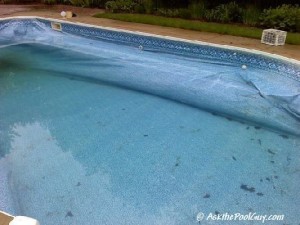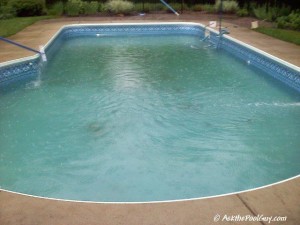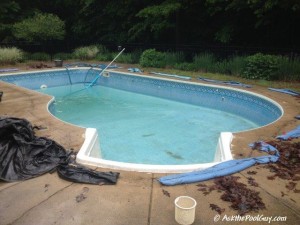
 There are invisible forces at work underneath your pool. These forces are known as hydrostatic pressure. This pressure is what forms cracks in the shell of your pool and bulges in your vinyl.
There are invisible forces at work underneath your pool. These forces are known as hydrostatic pressure. This pressure is what forms cracks in the shell of your pool and bulges in your vinyl.
Vinyl liners actually have an advantage over fiberglass pools because there are several fairly simple fixes that can help with the hydrostatic pressure.
How Does This Happen?
Many people think that if your vinyl liner is floating then you have a groundwater problem. This isn’t necessarily the case. As long as the water level in the pool is higher than the water level in the ground there will be enough internal pressure to keep the liner in place.
If your backyard doesn’t have proper drainage and keep the water away from the pool, then water will collect around your pool from rain and melting snow. Most likely this accumulation will connect with groundwater and swell above the pools water level. It’s usually around 4-6 inches below the ground. This will want to make the water levels in the pool and ground to equalize. A downward pressure then forms and causes the groundwater to exert pressure up against the shell of your pool. Any water that rises slightly above the surface level of the pool could be enough to cause the liner to shift.
What to Do:
The quick fix available is to run a pump between the liner and the pool wall. This removes the trapped water. Then you partially drain the pool to work out any of the wrinkles.
Another option is a well point. This provides a more permanent solution. In a well point, a 12 inch diameter pipe is inserted vertically into the ground. This provides a path for the water to well into. This is how it’s done:
Drill a hole about 1 or 2 feet deeper than the pool’s deep end. Make sure it’s wide enough to accommodate the pipe circumference. Then add a 1 or 2 food layer of gravel in the bottom. Make sure this level is about three quarter’s of an inch. Install a 12 inch PVC pipe and backfill around it. If you have a case of extreme groundwater, add an 18 or 24 inch diameter pipe instead of a 12 inch pipe.
An automatic submersible pump is then placed at the bottom. Set it up so it’s triggered when water in the pipe reaches a certain level. You will need a horizontal discharge pipe near the top of the vertical installation. This channels the water offsite. If you put a lid on it, you’re all set.
It’s not easy to determine the best location for the well point. Sometimes it’s a guessing game; other times pipe placement is obvious. We hope you experience the latter. If you have a body of water in your yard like a creek or pond, place the well pipe in between the body of water and your pool.
Fortunately, it doesn’t need to be an exact science. If you provide a place for the groundwater to go- it usually happily obliges.
A French drain is another option for aiding with groundwater. They offer subsurface hydrostatic relief.
First you have to dig a trench around the pool. If you have a deck, you might need to cut through some of it to place the drain close enough. The depth of the trench depends on a couple factors: site conditions and how much water is present. As long as the horizontal pipe is below the pool’s water level, there are no issues.
The next step is to drop landscape fabric down into the trench and put a layer of pervious gravel. This provides the water a path of least resistance (remember, water always chooses the path of least resistance). The fabric needs to encase the gravel.
Now it’s time to install the pipe. The pipe will have a series of holes. This is very important: make sure the holes are facing downward. This allows the water to seep up from the ground. It will then enter the trench and rise into the pipe. Make sure to channel the water into a solid drain pipe to carry it off correctly.
For many of these groundwater suggestions, it is best to consult a professional to ensure the job is done correctly.
Preventing the Bulge
You are more likely to notice a bulge or bubble in your vinyl liner after the winter season. This can easily be avoided during your winterization process. Prevention is always less expensive and less time consuming that fixing an issue.
Professionals usually lower the water well below the skimmer before they close a pool. This method may work on steep sites that shed water easily but be weary if you have a flat property.
Dropping the pool water too during winterization actually increases the chance of hydrostatic pressure. Make sure not to lower the pool water level lower than you actually need to.
